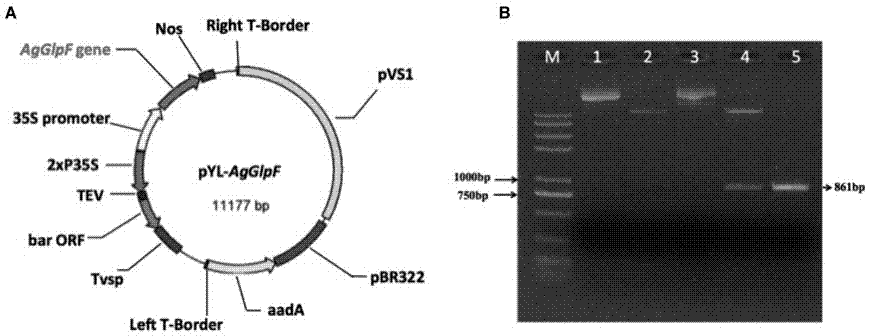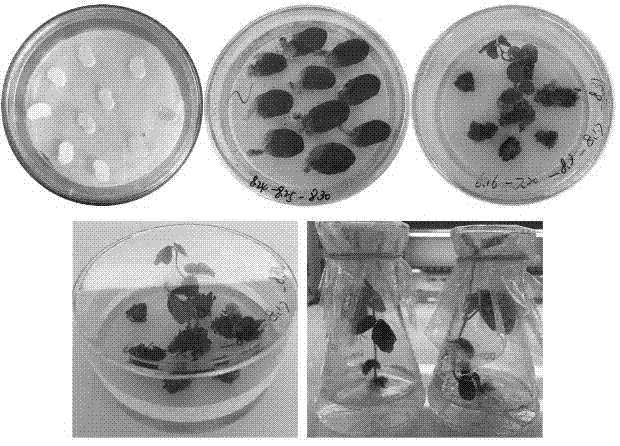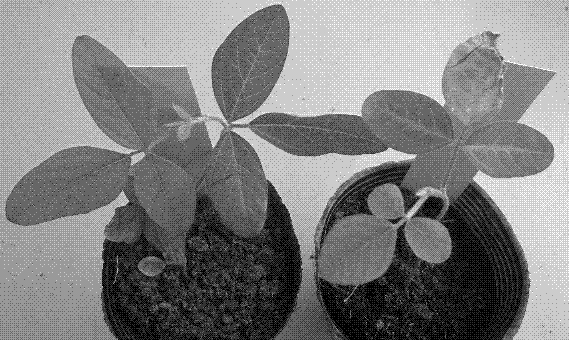Method for obtaining salt-tolerant transgenic soybean material
A transgenic soybean and gene technology, applied in genetic engineering, plant genetic improvement, botanical equipment and methods, etc., can solve the problems that have not been seen before, and achieve the improvement of salt tolerance, herbicide resistance and broad application prospects. Effect
- Summary
- Abstract
- Description
- Claims
- Application Information
AI Technical Summary
Problems solved by technology
Method used
Image
Examples
Embodiment 1
[0027] Example 1 Plant expression vector construction.
[0028] According to published on NCBI AgGlpF The nucleotide sequence of the gene (GenBank accession number KJ679500), artificially synthesized according to plant codon preference AgGlpF Gene. According to the molecular characteristics of multiple cloning sites of plant binary expression vectors, respectively in AgGlpF Introducing endonuclease upstream of the gene wxya Restriction site, downstream introduction of endonuclease SpeI Restriction sites.
[0029] Amplified by PCR AgGlpF The full-length sequence of the gene (861bp) was performed by double cutting and double joining wxya with SpeI After digestion, the AgGlpF The gene was connected to the pYL vector to obtain the expression vector pYL-AgGlpF ( figure 1 A), the constructed plasmid was sequenced and detected by enzyme digestion ( figure 1 B), the verified correct plant expression vector was transformed into Agrobacterium EHA101 for the next step of ...
Embodiment 2
[0030] Example 2 Agrobacterium-mediated genetic transformation of soybean.
[0031] In this study, selection with the target gene AgGlpF The Agrobacterium strain EHA101 was used to genetically transform the soybean recipient variety P3 using the genetic transformation method of soybean cotyledon nodes mediated by Agrobacterium tumefaciens.
[0032] The process of Agrobacterium-mediated soybean cotyledon node transformation method is shown in figure 2 , the basic process is as follows:
[0033] (1) After culturing Agrobacterium at 28°C for 16 hours, collect the cells and transfer them to YEP liquid medium until the OD600 value is 0.5-0.7 for later use;
[0034] (2) Select mature seeds of soybean recipient variety P3 and sterilize them with chlorine gas for 16 hours. After sterilization, put the seeds into the GM germination medium (medium formula refers to OLHOFT, etc.) and germinate in weak light for 16 hours;
[0035] (3) Cut the cotyledon nodes, divide the soybean seeds...
Embodiment 3
[0041] Example 3 Detection of glufosinate resistance in transgenic plants.
[0042]Since glufosinate is used as a screening marker in the plant expression vector, the method of smearing leaves with glufosinate can be used to quickly detect transgenic positive seedlings at the seedling stage of T0 transgenic materials.
[0043] Specific method: Dip a proper amount of glufosinate solution with a concentration of 135mg / L with a cotton swab, gently wipe half of the leaf, and smear water on the same leaf as a control, and observe the growth of the leaves after 3 to 5 days under normal light conditions. withered, it is not resistant to glufosinate ( image 3 ).
[0044] In this study, we transplanted 49 regenerated plants that were initially positive by Bar test strips to flower pots in the greenhouse for cultivation. Using the glufosinate resistance detection method, we finally obtained 36 transgenic materials of the T0 generation.
PUM
 Login to View More
Login to View More Abstract
Description
Claims
Application Information
 Login to View More
Login to View More - R&D
- Intellectual Property
- Life Sciences
- Materials
- Tech Scout
- Unparalleled Data Quality
- Higher Quality Content
- 60% Fewer Hallucinations
Browse by: Latest US Patents, China's latest patents, Technical Efficacy Thesaurus, Application Domain, Technology Topic, Popular Technical Reports.
© 2025 PatSnap. All rights reserved.Legal|Privacy policy|Modern Slavery Act Transparency Statement|Sitemap|About US| Contact US: help@patsnap.com



